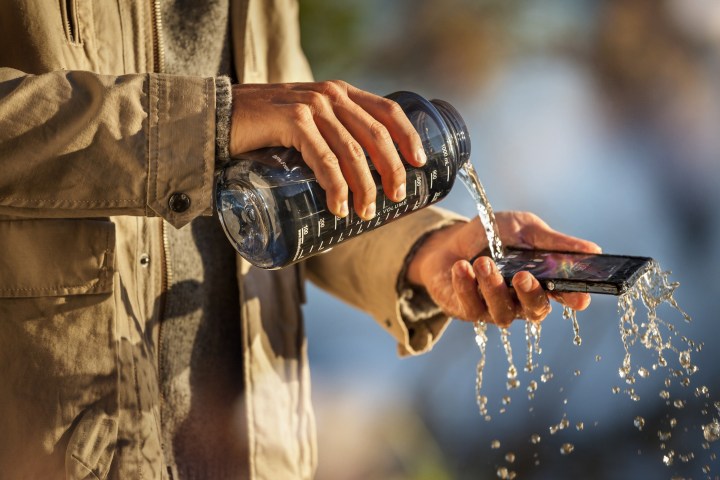
Water damage is the second biggest cause of smartphone failure today. Worldwide, nearly 900,000 smartphones get damaged by liquids every single day at an annual cost of more than $96.7 billion, according to IDC.
Manufacturers and insurers cover some of that, but most of the cost is borne by regular folks. It comes as no surprise, then, that water resistance featured prominently in a recent YouGov poll of most wanted smartphone features in the U.S. market. It came third, ahead of the best camera and hands-free technology. In case you’re wondering, battery life and shatter-proof screens topped the list.
Origins of waterproof phones
“We think every phone should be water resistant,” Ady Moores, CEO of P2i told Digital Trends at Mobile World Congress.
P2i provides a special water repellant coating for smartphones that delivers an IPX2 rating. Treated smartphones can withstand rain showers, spills, and humidity, but not full immersion. The company was spun out of the U.K. military in 2004 to find ways to commercialize a product that had originally been developed between the Gulf wars to protect uniforms against chemical weapons.

It operated in the military market until 2010, when a breakthrough came in the form of hearing aids. P2i treats 60 percent of the hearing aids on the market, and that led onto smartphones and a partnership with Motorola. All the Moto phones released in the last few years have been treated with P2i’s coating. The company has also partnered with Huawei, treating its flagship P8 and every succeeding model in the series, including the newly announced P10.
New tech makes it possible
The idea of a water resistant phone is still relatively new. Cast your mind back just four years to 2013, when Sony unveiled the Xperia Z. That was the first time we had seen a flagship smartphone that boasted a high degree of water resistance and didn’t look like a rubberized brick. It scored an IPX7 rating, which means that it can withstand depths of up to 1 meter for 30 minutes.
Samsung released the S4 Active the same year, which also scored an IPX7 rating, but it was a ruggedized version of the flagship S4. It would be a while before water resistant phones without flaps to seal the ports appeared on the scene.
“In the next two to four-year period every phone will be water resistant”
Last year’s iPhone 7 achieved an IPX7 rating and the Galaxy S7 scored an IPX8 rating. This year the LG G6 and Sony’s Xperia XZ Premium also scored an IPX8 rating. All are beautiful devices with open ports, but those IP ratings came at a cost.
“They have to put a milled aluminum frame, glue different openings, and engineer those devices very carefully,” explains Moores. “We estimate the manufacturing cost of a mechanically sealed IPX7 solution is somewhere between $8 and $15 per phone.”
By contrast, P2i’s coating is gas-based and can be applied at the end of the manufacturing line to the finished phone. It’s also a lot cheaper.
“Our technology is 50 to 60 cents per phone for IPX2 certification,” explains Moores. “But the real value of a coating versus a mechanical solution for manufacturers is not just that it brings the price down, it also gives you back the freedom of design.”
Manufacturers employing P2i’s coating don’t generally advertise it as a feature. They’re apparently content with improved reliability. Moores tells us that the coating has reduced average return rates for water damaged phones by between 40 and 50 percent.
Waterproofing will be standard
Whatever method is chosen, we’re thankful that water resistance is becoming a standard feature, for flagships, at least. Last year, of the smartphones sold that cost $600 or more, 95 percent were water resistant. That percentage falls rapidly with price. Only 25 percent of smartphones costing between $400 and $600, and 17 percent of mid-rangers in the $200 to $400 price bracket had any water protection.

That’s something P2i is working to change and the company has treated more than 175 million devices to date. A coating, versus a sealed solution, allows for replaceable batteries and easer repairs, but there are some other advantages, too.
“The difference between a P2i treated phone and a sealed phone is about two degrees Celsius,” explains Moores. “A coating allows you to keep the device open, so air can come in and out.”
It may be cheaper, easier to apply, and afford manufacturers more design freedom, but an IPX2 rated phone probably won’t survive a submersion, so the technology has a way to go yet.
“We are working on achieving the IPX7 rating with a coating,” Moores says. “We’d expect to see phones in the marketplace in late 2018 with that technology.”
As it becomes easier and cheaper for manufacturers to make their phones water resistant, we hope to see more and more of them do so.
“In the next two to four-year period every phone will be water resistant,” suggests Moores. “It will become an expectation.”
Editors' Recommendations
- 7 features we want to see in every 2021 smartphone
- What is UFS 3.0 storage? We asked an expert about the SSD for phones



